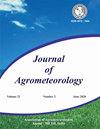评估 CMIP6 GCM 的性能以及对西孟加拉邦新冲积区 Boro 和 Kharif 季节的未来预测
Q3 Agricultural and Biological Sciences
引用次数: 0
摘要
本研究考察了 12 个 CMIP6 全球气候模型在西孟加拉邦新冲积区水稻作物种植季节(Boro(1 月至 5 月)和 Kharif(6 月至 10 月))的降雨量、最高气温和最低气温方面的总体表现。为了增加对结果的信心,使用了多种指数,即一致指数、误差指数和偏差估计指数。结果表明,CMIP6 模型能够充分再现观测到的两季平均气候以及最高和最低气温的年际变化,而在总共 12 个 GCM-CMIP6 模型中,只有少数模型(3-4 个模型)在降雨方面表现令人满意。各模式的排名显示,CNRM-ESM2-1 是 Kharif 季节表现最好的模式,MRI-ESM2-0 则是 Boro 季节表现最好的模式。ACCESS-CM2 和 MPI-ESM1-2-LR 分别在 Kharif 和 Boro 季节表现最差。此外,在中度情景(SSP2-4.5)和极端情景(SSP5-8.5)下,CNRM-ESM2-1 和 MRI-ESM2-0 分别用于预测 Kharif 和 Boro 季节的未来气候。与 Kharif 相比,预测 Boro 季节的变暖程度更高。预测结果显示,在中度和极端未来情景下,哈里发季节的降雨量都在增加,但波罗季节的降雨量却在减少。本文章由计算机程序翻译,如有差异,请以英文原文为准。
Evaluation of CMIP6 GCMs performance and future projection for the Boro and Kharif seasons over the new alluvial zones of West Bengal
Present study examined the overall performance of 12 CMIP6 GCMs for rainfall, maximum and minimum temperatures for rice crop-growing seasons i.e., Boro (January to May) and Kharif (June to October) over the new alluvial zone of West Bengal. A wide range of indices i.e., index of agreement, error indices and bias estimators were utilized to put more confidence on the results. Results indicated that CMIP6 models were able to reproduce observed mean climatology and inter-annual variability of maximum and minimum temperature adequately for both seasons while a smaller number of models (3-4 models) out of a total of 12 GCM-CMIP6 models showed satisfactory performance for rainfall. The ranks assigned to the models revealed that CNRM–ESM2–1 was the best-performing model for Kharif and MRI-ESM2-0 showed the highest skill for Boro. ACCESS-CM2 and MPI-ESM1-2-LR performed worst for Kharif and Boro seasons respectively. Further, CNRM–ESM2–1 and MRI-ESM2-0 were used to project the future climate for Kharif and Boro seasons respectively under both moderate (SSP2-4.5) and extreme scenarios (SSP5-8.5). Higher warming was projected during Boro season than Kharif. Projections revealed increasing rainfall during Kharif season but decreasing rainfall in Boro season in both the moderate and extreme future scenarios.
求助全文
通过发布文献求助,成功后即可免费获取论文全文。
去求助
来源期刊

Journal of Agrometeorology
农林科学-农艺学
CiteScore
1.40
自引率
0.00%
发文量
95
审稿时长
>12 weeks
期刊介绍:
The Journal of Agrometeorology (ISSN 0972-1665) , is a quarterly publication of Association of Agrometeorologists appearing in March, June, September and December. Since its beginning in 1999 till 2016, it was a half yearly publication appearing in June and December. In addition to regular issues, Association also brings out the special issues of the journal covering selected papers presented in seminar symposia organized by the Association.
 求助内容:
求助内容: 应助结果提醒方式:
应助结果提醒方式:


